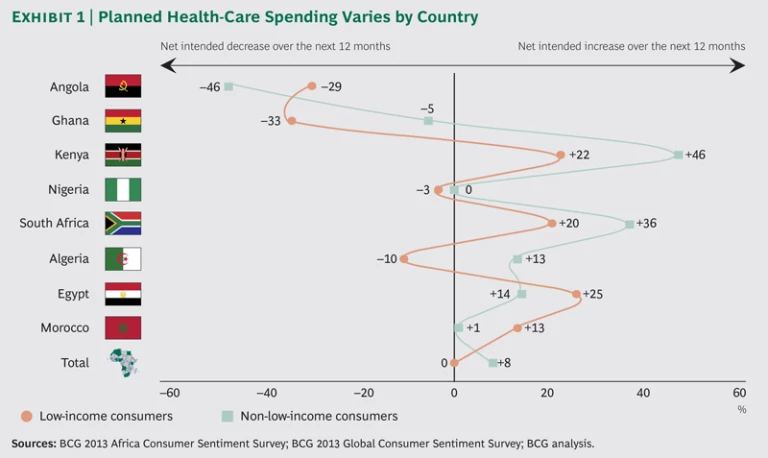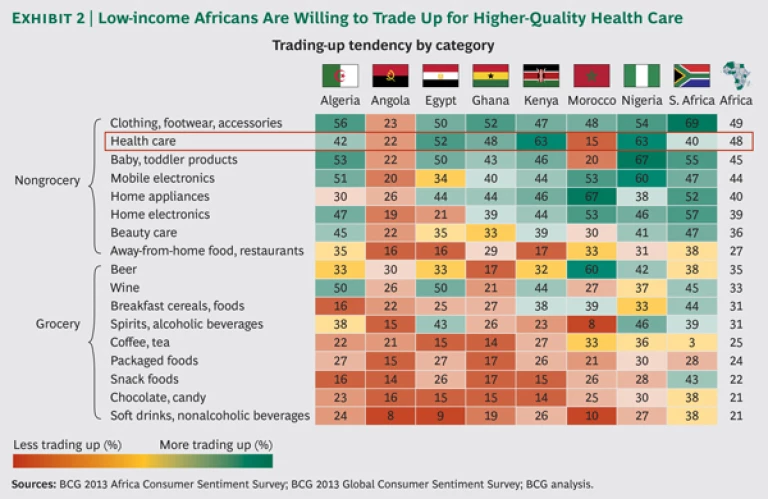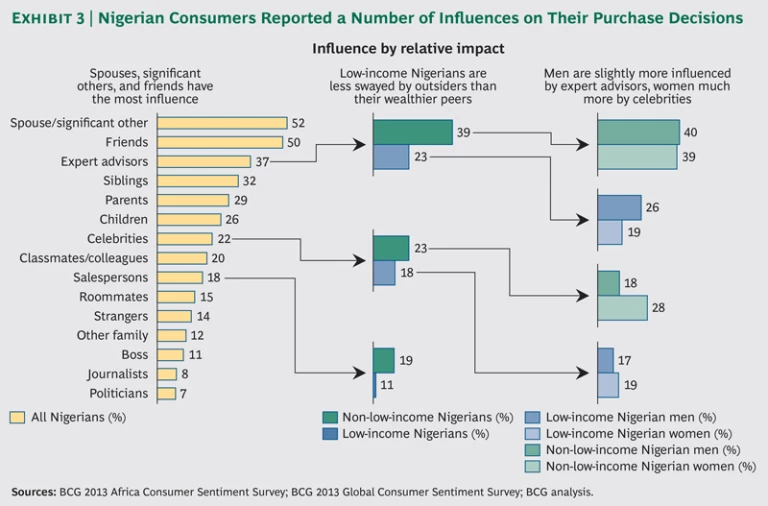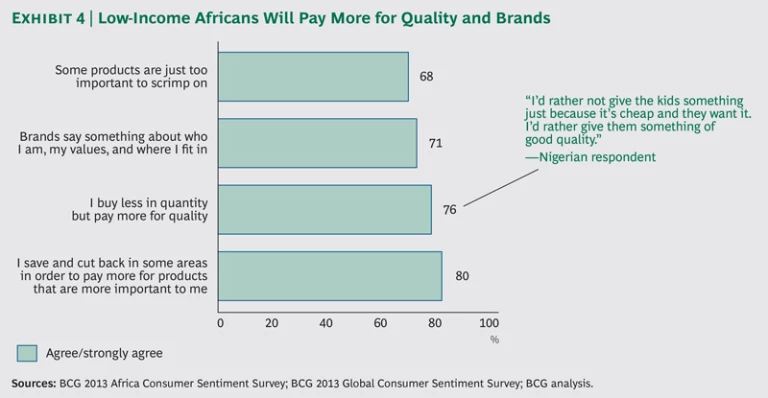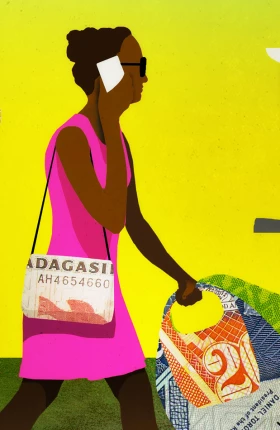Many multinational companies have built successful product categories and brands among African consumers by educating shoppers and adapting to local market needs. For instance, Dufil Prima Foods created a $400 million market from scratch in Nigeria by marketing its Indomie instant noodles as nutritious, affordable, and easy to prepare. In South Africa, Nestlé hired distributors to make its products available to consumers at the bottom of the income pyramid.
In contrast, some global health initiatives have had difficulty finding a market in Africa. For instance, an independent evaluation of the Affordable Medicines Facility–malaria found that although the cost of artemisinin combination therapies had come down in some African markets, a lack of availability and awareness among consumers had impeded adoption. Similarly, despite the efforts of many organizations to prevent HIV by providing condoms, condom usage is actually declining in many parts of Africa—a decline attributed to supply issues and inadequate awareness of the related health benefits. Interventions for nearly all diseases and health conditions in Africa—from malaria and HIV to diarrhea and other tropical diseases—have had problems with uptake and impact.
Although global health organizations such as NGOs, government agencies, bilateral organizations, donors, foundations, academic institutions, R&D institutions, and public-private partnerships have greatly improved the living conditions and life expectancy of Africa’s most vulnerable populations, much more still needs to be done—especially in sub-Saharan Africa. The underlying drivers of the global health burden are complicated, but three major factors often hinder the adoption of health interventions: limited awareness of the disease and its prevention or treatment; limited access to prevention or treatment due to distance or stockouts; and a lack of affordability caused by out-of-pocket clinic fees, the cost of products, or the cost of transportation to care providers.
Consumer products companies face similar obstacles, yet many have been able to reach African consumers and win their loyalty and hard-earned dollars. What are these companies doing differently? To find out, BCG analyzed how they develop a market for their products—even when their target populations have limited disposable income. (See Winning in Africa: From Trading Posts to Ecosystems , BCG report, January 2014.) We supplemented this research with findings from our recent Africa Consumer Sentiment Survey of nearly 10,000 consumers at all income levels across eight African countries. (See Understanding Consumers in the “Many Africas” , BCG Focus, March 2014.) The survey covered key areas such as consumer spending, budgeting, brand awareness, purchasing behaviors, advertising impact, and the influence of other media. (See “2013 Africa Consumer Sentiment Survey Methodology.”)
2013 AFRICA CONSUMER SENTIMENT SURVEY METHODOLOGY
For more than ten years, BCG has conducted an annual Global Consumer Sentiment Survey to gather information on consumer behaviors and trends across many countries. In 2013, for the first time, we added several African countries to the survey, enabling comparisons across the continent and with other emerging markets, such as China, India, and Brazil, as well as with mature markets. Altogether, the global survey reached 40,000 consumers in 25 countries and was conducted in 20 languages.
In Africa, we surveyed nearly 10,000 urban consumers in eight countries: Algeria, Angola, Egypt, Ghana, Kenya, Morocco, Nigeria, and South Africa. Respondents represented a mix of consumers of different ages and income and education levels. The survey explored topics related to income, spending, and budgeting; technology, mobile, and Internet usage; preferred retail-shopping locations; and banking habits.
The survey also assessed planned expenditures, trading up and down, brand preferences, and shopping behaviors in more than 20 product categories, including: automobiles; baby and toddler products; beauty care; beer; breakfast cereals and foods; chocolate and candy; clothing, footwear, and accessories; coffee and tea; consumer electronics; hair care products; health care; home appliances; insurance; mobile phones and devices; packaged food; restaurants and out-of-home eating; snacks; soft drinks and other nonalcoholic beverages; spirits and other alcoholic beverages; and wine.
Note: This sidebar originally appeared in Winning in Africa: From Trading Posts to Ecosystems (BCG report, January 2014). The Global Consumer Sentiment Survey is sponsored by BCG’s Center for Consumer and Customer Insight and funded by the firm’s Global Advantage and Marketing and Sales practices.
Africa’s Low-Income Consumers
Although BCG surveyed consumers at all income levels, this report focuses on lower-income Africans—those living on less than $1.80 to $2.30 per day—who are the primary target for many global health interventions. Our research showed that these consumers are highly aware of international brands, know their advertising slogans, aspire to purchase them, and are willing to spend more for them. Besides associating brands with quality, African consumers have a strong emotional attachment to brands, believing that they help express and define personal identity and values. Africans are twice as likely as consumers in other developing economies and three times more likely than consumers in developed countries to believe in the importance and power of brands. African consumers at all income levels hold this belief.
Africa’s low-income consumers are buying more than just branded beverages and packaged foods. Many also own electronics, durables, and other expensive items that may require months of saving. Favorite brands include well-known international names such as Nokia, LG, Samsung, Colgate, Cadbury, and Toyota. Even when money is tight, many African consumers will try to find a way to purchase the things they want. They’ll skip meals to buy airtime for their phones and pool resources with family members to buy bigger-ticket items. In fact, 80 percent of the low-income Africans we surveyed said that they save and cut back in some areas in order to buy the products that are most important to them.
African consumers are heavily influenced by friends, family, and community when making product choices, and more than 60 percent use the Internet to search for information, compare prices, and follow product trends. Moreover, 65 percent said they are aware of product details, such as technical benefits, performance, and construction quality. African consumers also know which retail outlets will have what they want. These insights suggest a highly informed and diligent purchasing process.
Health Care Purchases
When it comes to health care, low-income consumers in Africa spend roughly one-sixth of what they spend on food and beverages, half of what they spend on rent and transportation, and about two-thirds of what they spend on phone/Internet and beauty care. High-income consumers spend about three times more on health care per month than low-income Africans.
Future spending plans vary by region. More low-income consumers in Egypt, Morocco, Kenya, and South Africa than in the other African countries surveyed plan to increase their spending over the next 12 months, while most low-income consumers in Algeria, Angola, Ghana, and Nigeria plan to spend less. (See Exhibit 1.)
Despite these variations, most of the low-income consumers surveyed said they would spend more for higher-quality health-care products and services—a product category that ranked second among 17 categories in terms of the willingness to trade up, after clothing, footwear, and accessories. (See Exhibit 2.) The inclination to trade up differs slightly by country and is more muted in Angola and Morocco than elsewhere.
Product status appears to affect brand recall. Only 50 percent of consumers could recall a brand of medicine, compared with 98 percent who knew brands of mobile electronics and 80 percent who were familiar with clothing brands. These products are status symbols in Africa, but such high levels of familiarity are likely also due to more advertising by manufacturers and more word of mouth. After all, medicines are less likely to generate buzz than the latest fashions and technology. In addition, advertising by pharmaceutical companies is limited in some African countries. Still, 98 percent of low-income consumers could name a favorite toothpaste brand—usually Colgate—which suggests untapped potential for the branding of health care products.
Five Lessons from Consumer Products Companies
Could global health interventions in Africa achieve the same levels of brand recognition and spending that mobile phones and clothing enjoy among consumers? Promoting healthy practices is far more complex than selling candy bars or smartphones. But consumer products companies have overcome the problems of awareness, access, and affordability and are effectively reaching their target buyers: consumers with limited income. By learning from these companies and adapting their strategies, health organizations could better reach their target populations, build awareness and demand for needed interventions, and ensure that treatments are used properly.
Although they lack the huge marketing budgets of major multinational companies, global health organizations could increase the impact of their product development, marketing, and distribution dollars by using them in a smarter, more coordinated manner, drawing lessons from the best practices of private industry. Our analysis revealed five effective strategies.
Understand the many Africas. Africa is a very diverse continent, with no single solution for every market. Different consumer behaviors, cultures, preferences, and other factors will affect awareness of a particular health problem, the way in which treatment is received, and the willingness to pay. The characteristics of different markets also come into play. There may be government regulations and policies that restrict patient access and treatment; a range of market players—such as traditional healers, modern clinics, pharmacies, and other public and private entities—that offer competing products and services; and treatment alternatives such as home remedies. Sales and distribution challenges may vary as well. To succeed, health organizations must understand these differences and tailor their approaches accordingly.
Consumer segments within countries can also differ. For example, the typical Nigerian consumer relies on spouses, significant others, and friends for purchase advice. (See Exhibit 3.) But a deeper analysis of income, age, and gender differences shows that experts and celebrities play a meaningful role as well—especially among higher-income consumers. Among wealthier male Nigerians, 40 percent said that they found experts helpful, even ranking them ahead of their parents and siblings in terms of influence. Twenty-eight percent of wealthier women said they were influenced by celebrities, compared with 19 percent of low-income women. Similarly, lower-income Kenyan men are relatively more influenced by radio, while lower-income women are more influenced by promotions at the point of sale, and both groups are highly influenced by contests. By contrast, newspapers are most influential among wealthier Kenyans.
The ability to “commercialize” a global health product and bring it successfully to market should be just as important as achieving a scientific milestone—especially in Africa, where infrastructure problems, cultural factors, challenging regimens, side effects, and affordability can all affect adoption. Global health organizations need products and services that strike the right balance between technology and effectiveness, that can adapt to the specific needs of African consumers, and that increase the probability of uptake. These tradeoffs were clearly evident during the launch of the two rotavirus vaccines: Merck’s RotaTeq and GlaxoSmithKline’s Rotarix, both of which had relatively large packaging that increased the burden on an already overloaded cold chain. Both companies aimed to reduce package sizes postlaunch in order to reduce distribution challenges. In addition to packaging improvements, many manufacturers are striving for vaccines that require fewer doses, are more cost-effective and thermostable, and have vaccine vial monitors (which show whether a vaccine has been damaged by exposure to heat), all of which improve distribution and storage.
We recognize that the challenges of R&D in health care are different from those in other industries. Global health interventions usually have little commercial potential and are either funded by public-private partnerships or involve repurposing an existing product for use in a different region. Given funding limitations, the efficient use of resources is even more important in global health than in private-sector industries. A strong consumer orientation early in the product development process helps make more effective use of R&D budgets. At the same time, more rigorous portfolio management can increase the odds of making the right bets, ensuring that products are effective in the field with end users—not just in an R&D setting.
As noted earlier, up-front market and customer research——long a practice in the consumer products industry—can better align products with the needs of the target population. At the same time, watch out for any obstacles to distribution or market acceptance, such as infrastructure problems, side effects, challenging regimens, high costs, or package size. Consider, too, the delivery mechanism and ease of treatment. For instance, a surgical procedure might meet with more resistance than a noninvasive procedure, but sometimes the reverse is true. Male circumcision as a means of reducing HIV transmission has had limited uptake in some regions, but men have accepted the one-time procedure in other regions. Similarly, a pill may be preferable to an injection, but not always. Some women prefer an injection over the pill as a method of contraception because it is easier to conceal from their husbands.
Product mistakes can be costly to fix, and nonprofits typically have fewer resources than companies in the consumer products industry, which tend to have deeper pockets and are better able to absorb losses or reinvest to improve a product. Besides researchers and scientists, sales and marketing experts—ideally those with emerging-market expertise—should also be involved in the R&D process to provide a reality check as product development progresses.
Harness the power of brands. Africans know, love, and are loyal to brands—especially many international brands. Asked to name their favorites, 52 percent cited Nokia for mobile phones, almost a quarter mentioned LG for home electronics and appliances, and more than 40 percent said that Toyota was their top choice for automobiles. Quality also drives brand loyalty. A South African woman living with 12 relatives on $1 a day said it was important that her son take a branded candy bar that costs 1 rand (approximately 10 cents) to school every day; she didn’t want him to be made fun of because he had a cheap snack. Another woman said she would rather have her preferred yogurt brand two or three times per week than the cheaper yogurt every day.
In Africa, brands send powerful signals to consumers and to society alike. As noted earlier, African consumers strongly believe that well-known brands reflect who they are, their values, and where they fit in. Clearly, health organizations that want to build sustainable brands in Africa must produce quality products and market them effectively.
Once African consumers find a brand they love, they may be reluctant to switch. In our survey, “familiarity” was the third most common explanation for why a brand was preferred. Moreover, consumers are likely to extend those preferences to families of products—an umbrella effect that consumer companies capitalize on by creating product extensions and new varieties that shoppers are predisposed to favor. Consumer companies have found that strong brands, especially umbrella brands, make more efficient use of marketing dollars because they carry positive associations with consumers and allow for streamlined communications, advertising, and word of mouth. Research suggests that African consumers’ preference for international brands extends to some health and personal categories, such as toothpaste and some medicines, where Colgate, Close-Up, Panadol, and Doliprane are already well-known to consumers.
Some global health organizations recognize the power of brands and are striving to build them around different health products. Population Services International (PSI), a pioneer in the social marketing of global health, offers the high-quality, best-selling Trust condom in South Africa, Swaziland, Lesotho, and Botswana. By contrast, one branded, government-issued condom has been plagued by complaints of poor quality, product recalls, and allegations of bribery. A 2012 survey found that 95 percent of South Africans wanted the government to rebrand these condoms to make them more appealing and to encourage condom use. One respondent said, “The old brand has a lot of stigma attached to it. [Rebranding] might increase demand, especially for young people. We love to be seen using the latest brands.” But another consumer had a different view: “I would not want to be seen using a free government condom when I’m on a date. This will reduce my status. Even if the government were to rebrand, I’d rather buy one.”
Branding isn’t limited to commodity health products such as condoms and long-lasting insecticidal nets (which protect against mosquitoes). It can also be applied to pharmaceutical products, health companies, clinics (such as PSI’s Greenstar clinics in Pakistan), programs, marketing campaigns, and field organizations such as NGOs. For instance, although the U.S. was delivering billions of dollars in foreign assistance in the first few years of this century, most recipients had no idea of the source of the aid. But after USAID sent assistance under its “From the American people” branding program to Indonesia following the 2005 tsunami, that country’s favorable views of the U.S. nearly doubled.
Global health organizations should help build stronger brands by creating either regional brands across countries or umbrella brands associated with specific health interventions. For instance, an umbrella brand, graphic, and corresponding messaging for malaria and its related interventions (such as drugs, nets, and diagnostics) could be effective, as could a brand for child nutrition and health products. Grouping together and branding similar categories of products might be the most cost-effective way to build umbrella brands—especially given the number of interventions being introduced. Co-marketing across similar products would also make more efficient use of marketing dollars, especially if multiple organizations supported one campaign instead of executing many different, more fragmented marketing plans. Another approach is to partner with established products and brands to benefit from existing brand awareness and equity, or to work with private-sector companies to create a new umbrella brand for a portfolio of consumer health, personal care, and global health products. Roles will vary depending on the players and health system of the given country, but the principles apply to all products and services, whether they’re free, government distributed, or sold through the private sector.
Develop high-impact marketing and communications. From a product’s prelaunch and throughout its life cycle, successful consumer companies develop and communicate marketing messages that effectively convey the product’s value to the consumer. In 2010, PepsiCo capitalized on Africa’s first World Cup by creating a popular, star-studded music-video campaign that went viral, leading many Africans to believe that Pepsi, not Coca-Cola, was the official sponsor of the sporting event. Not content to stop there, PepsiCo revamped its global campaign—Live for Now—which resonates with the 70 percent of young African consumers who prefer established brands but want them to speak to their own generation.
Consumer companies use a number of best practices to optimize their marketing dollars in Africa. For instance, they spread their ad spending across multiple channels—including radio, print, television, billboards, mobile phones, and the Internet—based on what generates the most impact for the particular product and its target market. The most sophisticated companies identify short- and long-term performance indicators and use quantitative metrics to determine the return on their marketing investments as a guide in future marketing decisions. Other best practices include varying spending levels based on the product and target consumer and timing outlays—spending more when launching a product and scaling back afterwards to achieve a better return. Consumer companies understand that marketing investments fuel sales and that sales revenues fuel profitability and future innovations.
Although Africa is entering the digital age, traditional media outlets are still the most influential. (See Exhibit 5.) Six out of ten low-income consumers said that TV ads had the most impact on their purchase decisions, compared with 37 percent who cited radio and 25 percent newspapers. Television has the greatest influence in South Africa and Angola, where 75 percent of low-income consumers cited its impact. In Kenya, promotions, contests, and in-store experiences work particularly well, whereas Ghanaian and Nigerian consumers are most likely to be influenced by online and social media. One low-income South African consumer commented, “My cousin buys certain brands because of the contests on the box. You text the number to win money.” As the Internet becomes more pervasive and younger consumers come of age, health organizations must embrace digital marketing as well as more traditional media.
Clearly, one size doesn’t fit all when it comes to the many Africas. To succeed, global health organizations must understand the wide range of consumer preferences, behaviors, and influences. Detailed consumer data doesn’t always exist, however, and the quality of the data that is available may be questionable. To learn more about target customer segments and how to reach them, health organizations may need to invest in primary research.
Innovate with the target consumer and market in mind. Companies that win the loyalty of African consumers offer products designed for the target population, considering such factors as local tastes and preferences, willingness to pay, access to infrastructure and electricity, and logistical challenges. Many companies adapt existing products by changing the packaging to offer more affordable, single-size servings, for instance, or by modifying the flavor of snack foods to fit local tastes. Other companies create completely new products. Samsung developed a television with built-in power-surge protectors for the African market, and phones with “dual SIM” technology, long battery lifetimes, and standby times of up to 25 days to help circumvent electricity shortages.
Although price matters to many Africans, particularly those living on limited budgets, it is no longer the major obstacle to purchasing in certain countries. Our research showed that low-income consumers aren’t looking for the cheapest product. Sixty-eight percent said that some products were too important to scrimp on, and 76 percent said they value quality over quantity—and would pay more for it. (See Exhibit 4.) African consumers research the products they buy, seeking quality, performance, and good value. But they’ll also forgo unnecessary features in exchange for a lower price. African consumers might not need or want a product with all the bells and whistles available to buyers in developed markets.
In global health, coordinating a high-impact marketing campaign can be challenging, with different entities often involved at different places on the value chain. For example, the funder, the R&D entities, and the organization that deploys an intervention in the field and communicates results may be separate entities, or they may be loosely tied together in a public-private partnership. In some countries, multiple entities—each with different local and global partners and funding sources—may be involved in the same activities. This lack of integration can be problematic. Messaging can be inconsistent or conflicting, since communications are typically left to the organizations in the field, which often have smaller budgets and few mechanisms to coordinate messages, channels, and targets. As a result, marketing campaigns don’t always benefit from a well-coordinated, integrated approach and a critical mass of messages. Moreover, marketing funds are usually limited—and are among the first to be cut when budgets are squeezed.
It’s no wonder, then, that awareness and uptake of some global health products are sometimes slow. For instance, the Roll Back Malaria (RBM) Partnership identified a number of communication gaps that impeded the uptake of malaria interventions. Some of these included insufficient behavioral and social research to inform messaging; too much reliance on one-time promotional events and mass media instead of a range of channels and approaches, such as community outreach, schools, workplaces, and personal connections; and lack of information about the effectiveness of different messages, approaches, and channels. To help improve communications, RBM developed The Strategic Framework for Malaria Communication at the Country Level, 2012–2017, which addresses priorities, funding, and capacity building while ensuring that malaria-program communications strategies are “context-appropriate, evidence-based, and results-driven.” The strategy led to the development of a Communications Community of Practice through which partners collaborate to create more effective malaria communications through best-practice sharing, work planning, technical assistance, and other activities.
To improve the integration and impact of their marketing efforts, global health organizations should identify the current gaps in strategies, communications, and channels across the value chain. The next step is for all players to work together to develop consistent, effective marketing messages that offer a clear and convincing value proposition unified by a common vision. To ensure effective deployment, make sure that the marketing approach and the channels used are appropriate for the target audience and market.
Factors to consider when developing a communications plan include the complexity of the message, the degree of cultural sensitivity, the target population’s familiarity with the issue, and the purpose of the message—whether it is to create awareness, change behavior, or increase adoption and maintenance of an intervention. Social and behavioral research will likely be necessary to identify the right approach for each campaign.
Organizations should test all communications with small groups of target consumers before full-scale rollout and conduct further research postlaunch to see if any messages should be modified. Consider using a professional marketing agency or market research firm with expertise in private-sector marketing in Africa. Also explore ways to achieve marketing scale and greater impact with limited resources. For instance, conduct a small number of large, high-impact marketing campaigns instead of numerous small campaigns spread over time, or use only the most effective channels for a target demographic. Increase cost efficiency by synchronizing product launches across countries or regions using multiple channels, pooling marketing resources with other entities to maximize reach with limited dollars, and sharing marketing materials and messaging across organizations and countries. Measure the impact of different campaigns to understand which are the most effective, and use this information to shape future campaigns.
Since friends, family, experts, and celebrities can be extremely influential with African consumers, global organizations should use positive-word-of-mouth campaigns whenever possible. It may be more effective to educate the major source of influence for any intervention rather than the end user. For example, some of the more effective male-circumcision campaigns focus on traditional leaders, who then influence the target males. In other cases, focusing efforts on parents or schools may be most effective. Beta Healthcare, which makes the Mara Moja brand of pain reliever, relies on van sales in Kenya to reach consumers in rural areas. Sales representatives visit markets, provide free samples, and engage with consumers to create a positive experience centered on the Mara Moja brand. This type of marketing can create a “top-of-mind awareness and an emotional bond,” according to the company’s sales brochure, which build brand awareness and loyalty. And it appears to be working: our study found that Mara Moja is the second most favorite medicine brand in Kenya.
SMS technology and the Internet are other platforms for sharing information. FrontlineSMS helps HIV patients in Kenya by providing frequent health messages, and Mobile Midwife EHR in northern Ghana sends women voice or text messages with health information during pregnancy and information on vaccinations and children’s health after childbirth. The Internet and social media can also be effective tools. Low-income consumers are spending more time researching products and seeking information online. While their use in global health is still fairly new, these channels, which are more economical than traditional channels, will likely grow in use, importance, and impact. In fact, some organizations are already hiring technology experts to identify potential applications.
Global health organizations should identify and reuse best practices from previous campaigns as they develop new marketing outreach strategies. As consumer companies know, a good set of metrics can determine the most effective marketing investments. Things to measure might include the penetration or uptake of an intervention, a decrease in the prevalence of a health issue, or increased awareness of a problem or treatment. A more analytical approach can help organizations track and measure an intervention’s progress toward the goals of awareness, adoption, and sustainability and provide insights for future marketing campaigns.
Creatively expand distribution and access. Distribution and logistical challenges are consistently cited as key barriers to the uptake of global health interventions. For example, 47 percent of low-income consumers in Nigeria said that availability was the top hurdle to purchasing their favorite brands—even more than price, which was cited by 40 percent.
The best consumer companies ensure that their products are where their customers shop, from the traditional market stall or small spaza shop to the modern retailer. For instance, Unilever is bringing its successful direct-to-consumer program to Africa to better reach consumers at the bottom of the economic pyramid. Similarly, Dufil Prima provides carts to street vendors of its Indomie-brand noodles. Many consumer companies also develop training programs to get the most out of their distributors. Diageo, known for its leading alcohol brands, teaches its distributors basic financial and sales demand analysis to drive revenues. Other companies make it easy for even the smallest shops to market and sell their products by providing signage, shipping products in cases that turn into compact displays suited to smaller stores, offering small-pack sizes at the right price points, and using wholesalers and other third parties to expand distribution.
Since most African consumers buy health products at pharmacies, drug stores, and clinics, health organizations should seek to expand distribution in these outlets by ensuring product availability in urban and rural outposts alike. At the same time, make sure that vendors know how to use products properly and are aware of their attributes. It’s also important to extend distribution of products that don’t require a health worker’s support to retail locations that are growing in popularity, such as modern supermarkets, general stores, and specialty retailers. Even street vendors, market stalls, and automated kiosks are possibilities in cases where a lack of medical knowledge will not interfere with treatment or proper usage. Decisions such as these must be made on a case-by-case basis, depending on the product, the local market, and the available channels.
To improve access, global health organizations should follow the lead of consumer companies and develop creative distribution strategies suitable for the product and market. For example, Vodacom, a regional telecommunications company based in South Africa, set up nearly 100,000 points of sale through wholesalers, franchisers, and independent contractors in Tanzania and other countries to support the rollout of M-Pesa, a mobile cash-transfer system. Vodacom also partners with Gimme That!, a program focused on entrepreneurship in South Africa, to recruit and train young people to sell prepaid airtime and other phone products and services on commission.
Another approach is to partner with private or public entities and NGOs with similar distribution goals. Project Last Mile is a partnership between Coca-Cola and Tanzania’s government-run medicine-distribution network that aims to build a more efficient supply chain using the company’s proven logistics models. The program has been so successful that Coca-Cola is expanding it in Tanzania and is setting up similar programs in Mozambique and Ghana. Ensuring continued supply is also important. SMS for Life, a public-private-sector partnership, has reduced malarial-drug stockouts by 67 percent by having clinics use SMS technology to send information on their inventory levels to distribution centers, which then send replenishment stock.
Global health organizations are fighting to help improve the quality of life and alleviate the cycle of poverty that affects many Africans. But to reach and win African consumers, organizations must confront three challenges: inadequate awareness, limited access, and lack of affordability. The success of consumer companies provides a playbook for overcoming these hurdles. By following the five key lessons outlined above, organizations can sharply improve their impact on Africa’s most at-risk populations.
Acknowledgments
The authors would like to thank Abdeljabbar Chraïti, Belinda Gallaugher, Grace Kuo, Stefano Niavas, and Peter Ullrich for research and other contributions.
